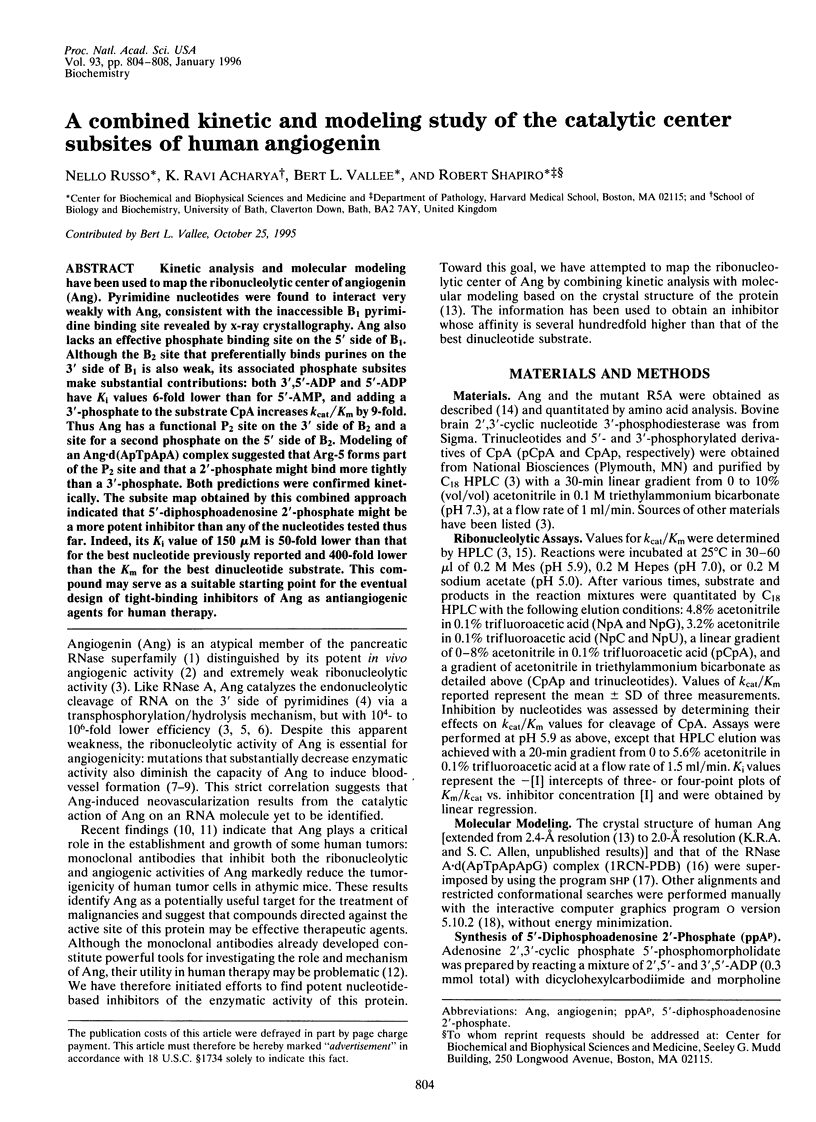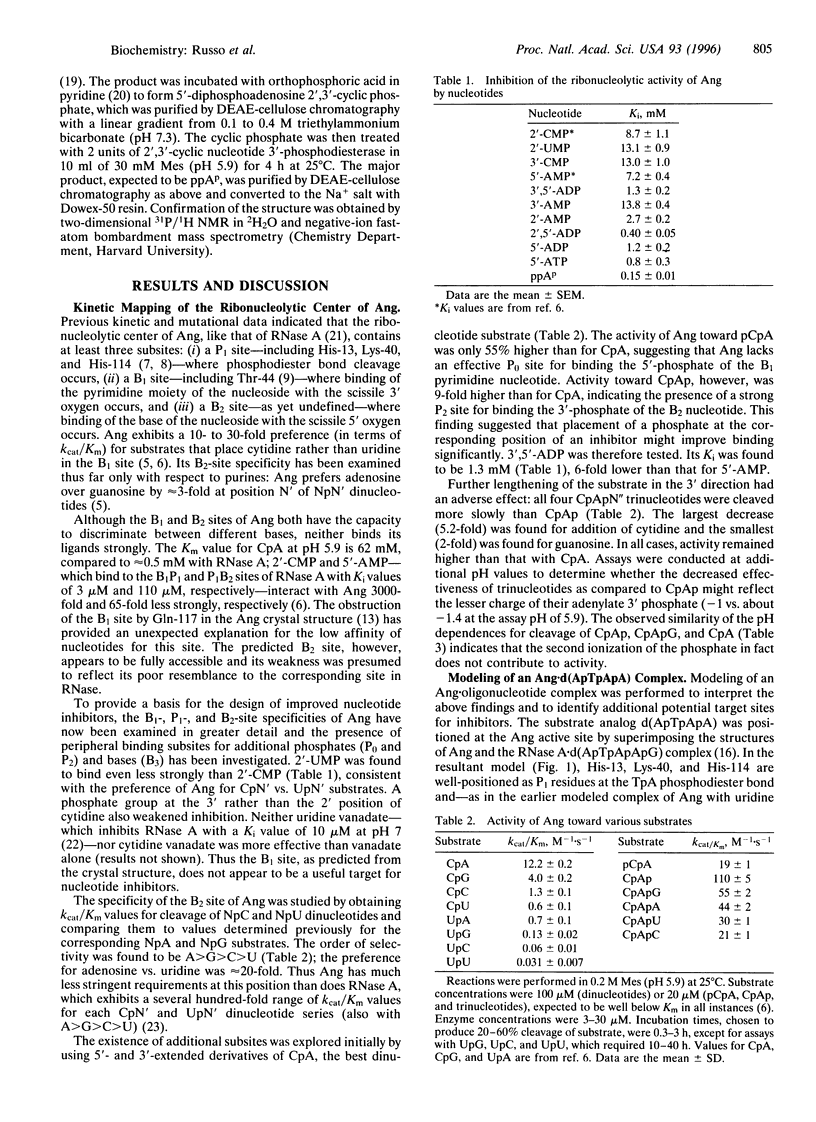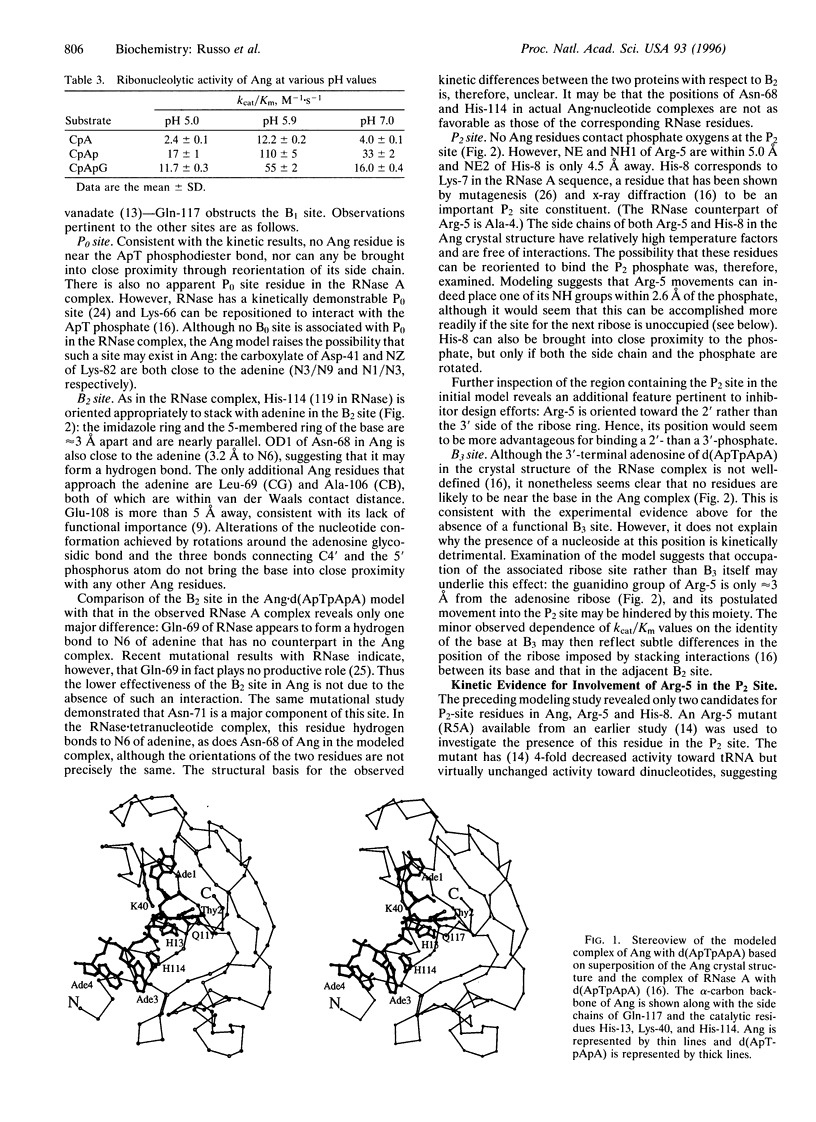Abstract
Kinetic analysis and molecular modeling have been used to map the ribonucleolytic center of angiogenin (Ang). Pyrimidine nucleotides were found to interact very weakly with Ang, consistent with the inaccessible B1 pyrimidine binding site revealed by x-ray crystallography. Ang also lacks an effective phosphate binding site on the 5' side of B1. Although the B2 site that preferentially binds purines on the 3' side of B1 is also weak, its associated phosphate subsites make substantial contributions: both 3',5'-ADP and 5'-ADP have Ki values 6-fold lower than for 5'-AMP, and adding a 3'-phosphate to the substrate CpA increases Kcat/Km by 9-fold. Thus Ang has a functional P2 site on the 3' side of B2 and a site for a second phosphate on the 5' side of B2. Modeling of an Ang-d(ApTpApA) complex suggested that Arg-5 forms part of the P2 site and that a 2'-phosphate might bind more tightly than a 3'-phosphate. Both predictions were confirmed kinetically. The subsite map obtained by this combined approach indicated that 5'-diphosphoadenosine 2'-phosphate might be a more potent inhibitor than any of the nucleotides tested thus far. Indeed, its Ki value of 150 microM is 50-fold lower than that for the best nucleotide previously reported and 400-fold lower than the Km for the best dinucleotide substrate. This compound may serve as a suitable starting point for the eventual design of tight-binding inhibitors of Ang as antiangiogenic agents for human therapy.
Full text
PDF




Selected References
These references are in PubMed. This may not be the complete list of references from this article.
- Acharya K. R., Shapiro R., Allen S. C., Riordan J. F., Vallee B. L. Crystal structure of human angiogenin reveals the structural basis for its functional divergence from ribonuclease. Proc Natl Acad Sci U S A. 1994 Apr 12;91(8):2915–2919. doi: 10.1073/pnas.91.8.2915. [DOI] [PMC free article] [PubMed] [Google Scholar]
- Boix E., Nogués M. V., Schein C. H., Benner S. A., Cuchillo C. M. Reverse transphosphorylation by ribonuclease A needs an intact p2-binding site. Point mutations at Lys-7 and Arg-10 alter the catalytic properties of the enzyme. J Biol Chem. 1994 Jan 28;269(4):2529–2534. [PubMed] [Google Scholar]
- Curran T. P., Shapiro R., Riordan J. F. Alteration of the enzymatic specificity of human angiogenin by site-directed mutagenesis. Biochemistry. 1993 Mar 9;32(9):2307–2313. doi: 10.1021/bi00060a023. [DOI] [PubMed] [Google Scholar]
- Fett J. W., Strydom D. J., Lobb R. R., Alderman E. M., Bethune J. L., Riordan J. F., Vallee B. L. Isolation and characterization of angiogenin, an angiogenic protein from human carcinoma cells. Biochemistry. 1985 Sep 24;24(20):5480–5486. doi: 10.1021/bi00341a030. [DOI] [PubMed] [Google Scholar]
- Filman D. J., Bolin J. T., Matthews D. A., Kraut J. Crystal structures of Escherichia coli and Lactobacillus casei dihydrofolate reductase refined at 1.7 A resolution. II. Environment of bound NADPH and implications for catalysis. J Biol Chem. 1982 Nov 25;257(22):13663–13672. [PubMed] [Google Scholar]
- Fontecilla-Camps J. C., de Llorens R., le Du M. H., Cuchillo C. M. Crystal structure of ribonuclease A.d(ApTpApApG) complex. Direct evidence for extended substrate recognition. J Biol Chem. 1994 Aug 26;269(34):21526–21531. doi: 10.2210/pdb1rcn/pdb. [DOI] [PubMed] [Google Scholar]
- Harper J. W., Vallee B. L. A covalent angiogenin/ribonuclease hybrid with a fourth disulfide bond generated by regional mutagenesis. Biochemistry. 1989 Feb 21;28(4):1875–1884. doi: 10.1021/bi00430a067. [DOI] [PubMed] [Google Scholar]
- Iwahashi K., Nakamura K., Mitsui Y., Ohgi K., Irie M. Further evidence for the existence of the p0 site in the active site of ribonuclease. The binding of thymidine 3',5'-diphosphate to ribonuclease. J Biochem. 1981 Dec;90(6):1685–1690. doi: 10.1093/oxfordjournals.jbchem.a133644. [DOI] [PubMed] [Google Scholar]
- Jones T. A., Zou J. Y., Cowan S. W., Kjeldgaard M. Improved methods for building protein models in electron density maps and the location of errors in these models. Acta Crystallogr A. 1991 Mar 1;47(Pt 2):110–119. doi: 10.1107/s0108767390010224. [DOI] [PubMed] [Google Scholar]
- Lee F. S., Vallee B. L. Characterization of ribonucleolytic activity of angiogenin towards tRNA. Biochem Biophys Res Commun. 1989 May 30;161(1):121–126. doi: 10.1016/0006-291x(89)91569-6. [DOI] [PubMed] [Google Scholar]
- Lindquist R. N., Lynn J. L., Jr, Lienhard G. E. Possible transition-state analogs for ribonuclease. The complexes of uridine with oxovanadium(IV) ion and vanadium(V) ion. J Am Chem Soc. 1973 Dec 26;95(26):8762–8768. doi: 10.1021/ja00807a043. [DOI] [PubMed] [Google Scholar]
- Olson K. A., Fett J. W., French T. C., Key M. E., Vallee B. L. Angiogenin antagonists prevent tumor growth in vivo. Proc Natl Acad Sci U S A. 1995 Jan 17;92(2):442–446. doi: 10.1073/pnas.92.2.442. [DOI] [PMC free article] [PubMed] [Google Scholar]
- Olson K. A., French T. C., Vallee B. L., Fett J. W. A monoclonal antibody to human angiogenin suppresses tumor growth in athymic mice. Cancer Res. 1994 Sep 1;54(17):4576–4579. [PubMed] [Google Scholar]
- Russo N., Shapiro R., Acharya K. R., Riordan J. F., Vallee B. L. Role of glutamine-117 in the ribonucleolytic activity of human angiogenin. Proc Natl Acad Sci U S A. 1994 Apr 12;91(8):2920–2924. doi: 10.1073/pnas.91.8.2920. [DOI] [PMC free article] [PubMed] [Google Scholar]
- Shapiro R., Fett J. W., Strydom D. J., Vallee B. L. Isolation and characterization of a human colon carcinoma-secreted enzyme with pancreatic ribonuclease-like activity. Biochemistry. 1986 Nov 18;25(23):7255–7264. doi: 10.1021/bi00371a002. [DOI] [PubMed] [Google Scholar]
- Shapiro R., Fox E. A., Riordan J. F. Role of lysines in human angiogenin: chemical modification and site-directed mutagenesis. Biochemistry. 1989 Feb 21;28(4):1726–1732. doi: 10.1021/bi00430a045. [DOI] [PubMed] [Google Scholar]
- Shapiro R., Riordan J. F., Vallee B. L. Characteristic ribonucleolytic activity of human angiogenin. Biochemistry. 1986 Jun 17;25(12):3527–3532. doi: 10.1021/bi00360a008. [DOI] [PubMed] [Google Scholar]
- Shapiro R., Vallee B. L. Site-directed mutagenesis of histidine-13 and histidine-114 of human angiogenin. Alanine derivatives inhibit angiogenin-induced angiogenesis. Biochemistry. 1989 Sep 5;28(18):7401–7408. doi: 10.1021/bi00444a038. [DOI] [PubMed] [Google Scholar]
- Strydom D. J., Fett J. W., Lobb R. R., Alderman E. M., Bethune J. L., Riordan J. F., Vallee B. L. Amino acid sequence of human tumor derived angiogenin. Biochemistry. 1985 Sep 24;24(20):5486–5494. doi: 10.1021/bi00341a031. [DOI] [PubMed] [Google Scholar]
- Stuart D. I., Levine M., Muirhead H., Stammers D. K. Crystal structure of cat muscle pyruvate kinase at a resolution of 2.6 A. J Mol Biol. 1979 Oct 15;134(1):109–142. doi: 10.1016/0022-2836(79)90416-9. [DOI] [PubMed] [Google Scholar]
- Tarragona-Fiol A., Eggelte H. J., Harbron S., Sanchez E., Taylorson C. J., Ward J. M., Rabin B. R. Identification by site-directed mutagenesis of amino acids in the B2 subsite of bovine pancreatic ribonuclease A. Protein Eng. 1993 Nov;6(8):901–906. doi: 10.1093/protein/6.8.901. [DOI] [PubMed] [Google Scholar]
- UKITA T., WAKU K., IRIE M., HOSHINO O. Research on pancreatic ribonuclease. I. The inhibition of cyclic phospho-diesterase activity of bovine pancreatic ribonuclease by several substrate analogues. J Biochem. 1961 Nov;50:405–415. doi: 10.1093/oxfordjournals.jbchem.a127467. [DOI] [PubMed] [Google Scholar]
- WITZEL H., BARNARD E. A. Mechanism and binding sites in the ribonuclease reaction. II. Kinetic studies on the first step of the reaction. Biochem Biophys Res Commun. 1962 May 4;7:295–299. doi: 10.1016/0006-291x(62)90194-8. [DOI] [PubMed] [Google Scholar]
- Waldmann T. A. Monoclonal antibodies in diagnosis and therapy. Science. 1991 Jun 21;252(5013):1657–1662. doi: 10.1126/science.2047874. [DOI] [PubMed] [Google Scholar]


